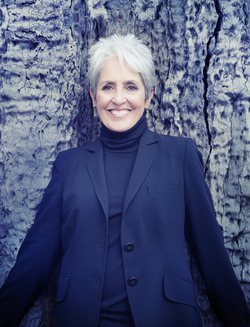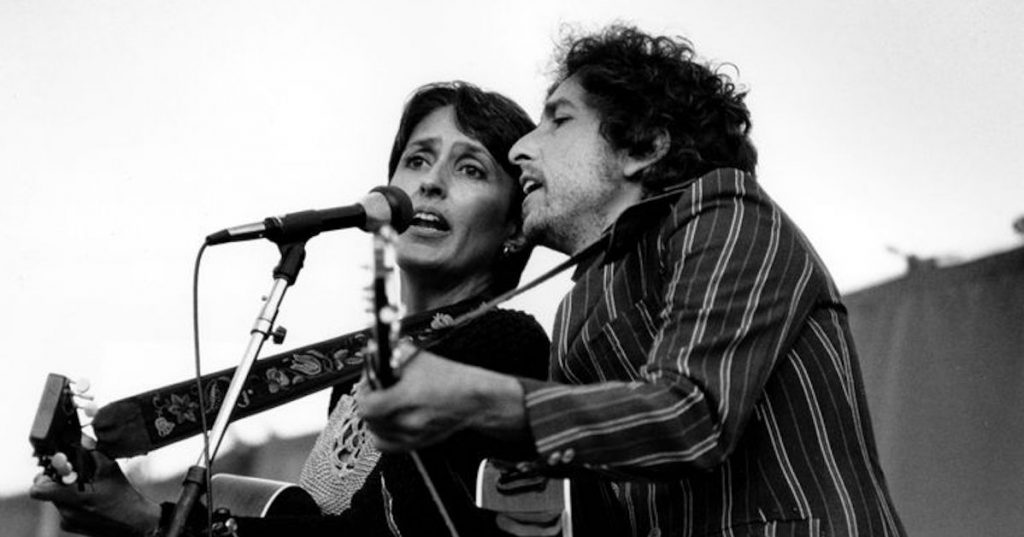Forever Young Joan Baez Upload to Facebook Likes
Joan Baez Interview: On Dylan, Aging and Her Adieu Tour
by

Joan Baez
In 1977, Judas Priest threw their fans a sharp-breaking curveball with a difficult-rocking cover of Joan Baez 's "Diamonds and Rust," released by her two years prior. The initial idea may take been that Priest was goofing—the original song was so out of their genre, and then identified with a human relationship Baez had had with Bob Dylan. But information technology chop-chop became articulate they were reconfiguring it, putting this song of loss and bittersweet reflection on their own fierce terms. And it worked.
Really well.
Then, when talking with Baez, we couldn't help asking what she thought of Priest's version.
"I love information technology!" she said, on the phone from her Northern California dwelling house. "I listened to it the other solar day because it popped upwards [on a playlist]. Of course, I don't write 'cover' kind of songs so having that covered was a big thrill for me."
And, maybe, it earned the vocalist-songwriter just a flake of unexpected cash. "I oasis't thought almost it," she said, with a laugh. 'I'll have to check."
Baez, born Jan. 9, 1941, has been with the states on the folk scene—sometimes crossing over into the pop/stone world—since playing the Newport Folk Festival in 1959, "at the outset of fourth dimension, before they made guitars," she one time joked.
Baez recorded her eponymous, soonhoped-for-reissued debut album the following yr and became i of '60s music's icons of activism alongside her famous ane-time beau, Dylan. While she'southward written songs, she'south all-time known as an interpreter—bringing others' music to higher public awareness—and in 1971 she scored her only superlative x hit single with the Band'due south "The Night They Drove Old Dixie Down."
Watch Joan Baez sing "The Night They Collection Erstwhile Dixie Down" on The Midnight Special
Dylan all the same plays a part in Baez'south life—his music, not him personally. In the interview that follows, she talks about putting Dylan baggage aside, relearning to beloved the man'south music via her portraiture. In 2012, Baez started painting seriously—she'd been doing information technology since she was a child—and had an exhibit in San Francisco last year called "Mischief Makers." She painted portraits of Martin Luther Male monarch Jr., her ex-husband David Harris, John Lewis, Harry Belafonte, Vaclav Havel, herself and, yes, Dylan.
When we spoke in 2018, Baez—backed by multi-instrumentalist Dirk Powell, percussionist Gabriel Harris and vocalist Grace Stumberg—was in the midst of her adieu bout, in support of her new album, Whistle Down the Current of air.
Heed to the championship track from Whistle Downwardly the Wind
Best Classic Bands: Yous've been very upfront lately most your voice, the changes it'due south gone through, the work yous've had to exercise.
Joan Baez: The vocal cords are just difficult. When someone first saw me at Newport I didn't know what a vocal coach was from a hole in the ground. Then, I ever had this paradigm of myself as this Miss Natural Talent and so I'm sure I waited to get assistance until way also long, and that hasn't helped the pass up of the muscle. Simply I'm happy, by the way, with what I have.
How take you adjusted?
First of all, someone finally convinced me to get down off my high horse and go meet a vocal coach because things weren't happening the way I wanted them to happen. I was 35 and I've done information technology ever since. Some of the coaches have changed, for different reasons. The most of import one, I think, was the outset one considering he was classically trained and simply wonderful and opened up a whole other tool box for me.

Joan Baez
Then, he passed on and I did several other people and most half-dozen years agone I was thinking, "Oh boy, this is the finish, I tin't pull this together," and [I saw] an ENT guy, and said, "Mayhap at that place's something interfering with whatsoever—warts on my chin or something." And, he said, "No, everything was fine." And I said, "So, this is it for 71?" and he said, "This is perfect for 71." I said, "I'm going to shoot myself," and he said, "Would you like to encounter my song therapist?" So, I said "Sure." This woman was young and she's amazing and I see her once every three or 4 months. The start three sessions she gave me this amazing corporeality of tools that I didn't know about, that I didn't have, and [my voice] was recognizably different by the time I was on the road afterward. I'one thousand comfy and happy. I'm not trying to reach notes that I can't attain anymore and I'grand not grieving nearly it. I'm working on what I have, which I like a lot.
You're at present in the midst of a farewell tour. What made you recall now information technology'south fourth dimension to hang up the guitar?
It's more me hanging upward the bus. It's more the extended get-up-in-the-morning, get-on-the-bus and go-to-the-prove. Sometimes you get very tired. And for sure the vocal cords are just hard. I love the new album and I honey the concerts, but it's taxing.
What adjustments have you fabricated in concert?
I had to give up sure songs I detest giving up and one of them was [Dylan's] "Forever Young." The woman who sings with me, Grace [Stumberg], she'south immature and she's brilliant and she's fun. The audio man said, "Why don't y'all permit her take the loftier annotation?" So, we made this cute duet out of it. No one's going to intendance who's taking that loftier notation. It came out brilliantly.

Bob Dylan and Joan Baez at Peace Sunday concert, 1982
You brought upwards "Forever Young" so I'll risk your "Fourth dimension Rag' wrath past asking well-nigh Bob … [Baez wrote the vocal "Fourth dimension Rag" in 1977 most Time magazine interviewing her and simply really wanting to know most Dylan.]
I don't have that anymore. [laughs].
Whew. You've been doing half-a-dozen Dylan songs in concert. What motivates you to do so?
Information technology'due south just the easiest, the well-nigh fun and virtually people react to it in a certain mode. In a way, it'due south the closest thing we have to a movement when you sing something like that [Dylan anthems]. There's such a response from the public and such a response from me. It comes from down in my gut somewhere. Really, afterwards all the BS over the years between me and Bob…I never knew how he felt just I started doing his portraits. Past the second portrait, I put on all his music randomly and I only cried. I thought "Good lord, what am I carping most? I got to know this guy. I got to sing with this guy." Any stuff that was still left vanished. Annihilation that was resentful or stupid simply went. What a treat was that.
You sing those songs a whole lot amend than he would if he chose to sing them today, which he mostly doesn't.
That's true. I remember hearing "The Times They Are A-Changin'" sung at the kids' march—the students from Parkland [High School]—and hearing that sung past a younger person, I thought, "Was that the only thing they could find?" Because the youth at this point does not have an anthem that really competes with that in whatever mode, shape or form. That tells us a lot about those songs. I dear doing those songs and no longer have a trouble with how many Bob Dylan songs I sing in a prepare. I'll sing all I want.
Heed to Baez and Dylan duet on "With God on Our Side" at Newport in 1963
Many people identify you lot with idealism and hope. Have y'all found whatsoever sort of equilibrium between the darkness of today and idealism?
Yeah, y'all have to or I wouldn't bother getting up—and some mornings I don't. Simply I think the trick right now is the we-shall-overcome-this-in-us has to be sort of like the Parkland kids. They know what it is they want to overcome. Now, that's a possibility. And I retrieve they get our back up. I retrieve the people who are doing work with refugees all over the world, in dissimilar cases, you pick your level of success and [endeavour to] live upward to it. You have overcome that much, only to think in the broad sense and in the long sense.
You were inducted into the Rock and Roll Hall of Fame final twelvemonth. Some people said, "Joan Baez? Stone 'north' gyre? Isn't she a folk vocalizer?" What did it mean to you?
Well, it was either "What am I doing here?" or "Why the fuck did they wait so long?" Somewhere in between those.

Joan Baez's latest album, Whistle Downward the Wind
Back to the '60s, the cartoonist Al Capp, who had "Fifty'il Abner" in hundreds of newspapers, fabricated you lot into a graphic symbol, an object of parody. Do you remember that?
Oh my god, vaguely. [He called me] Joanie Phoney.
It's kind of a laugh now, but back then? Did it hurt?
No. I had two things [going on]. One was the people who were around me. I was still suggestible at that historic period and they were maxim "You lot can't permit him get away with that!" In my head, a voice was saying, "Why not?" I didn't really care. But the influence from the outside was really stronger and I got myself all irate nigh it, only really it was not a big deal for me. I felt that my managing director [Albert Grossman] had been more insulted than I had. They depicted him as a coin-grubbing Jew.
Well, when the other side goes after y'all…
You've washed something right.
Music and politics are intertwined through your life and music. Where do they fit now?
I think equally long as nosotros maintain a loftier bar of deniability and practically no expectations, they are a part of all of our lives in a style they never take been before.
Related: Why was Joan Baez dancing on stage at a Ringo Starr All-Starr Band testify?
Some people might say you're singing to an echo bedroom, only while it may be true to some extent, you are building a sense of customs.
There is a customs. Exactly. So, "You lot're singing to the choir"? Y'all bet I'm singing to the choir; those are the ones who start to march.
Watch Joan Baez sing "Diamonds and Rust"
Related: "Diamonds and Rust" – How the song came to be
- About
- Latest Posts
![]()
Source: https://bestclassicbands.com/joan-baez-interview-9-13-18/?fbclid=IwAR192BYWGyJZhj9W12J8Ea2UahLn_c3M3l86jWuwgo5ucUmdPnym9ypf3iw
0 Response to "Forever Young Joan Baez Upload to Facebook Likes"
Post a Comment